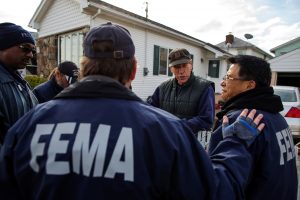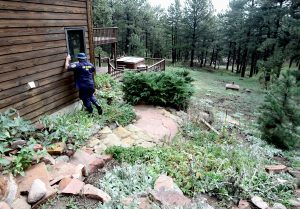
By Andy Sullivan
WASHINGTON (Reuters) – As Hurricane Irma bore down on Florida last September, the top U.S. disaster-response official ordered all hands on deck.
With 4,500 Federal Emergency Management Agency staffers already helping survivors of Hurricane Harvey in Texas, FEMA chief Brock Long told managers in an internal memo to ready every member of the agency’s on-call reservist workforce for deployment.
In the following months, thousands of FEMA reservists, who account for about half of the agency’s disaster-response personnel, would descend on Florida, Puerto Rico, California and elsewhere to help recovery efforts after an unprecedented string of natural disasters.
But not all would respond. About 500 reservists, or one of every twelve workers, ignored FEMA’s deployment request, current and former officials told Reuters.
“We didn’t even hear from them,” Patrick Hernandez, who oversees FEMA’s disaster workforce, said in an interview. “We need to get people in here who understand the system and adhere to the protocols.”
With the 2018 hurricane season already underway, FEMA is scrambling to hire more people who are willing to depart at a moment’s notice for assignments that can last months at a stretch.
Internal documents obtained through a Freedom of Information Act request show the agency’s disaster-response force is understaffed by 26 percent. And as last year revealed, many of those who sign up don’t always respond when needed.
That comes at a cost. At times, staffing shortages force FEMA to shuffle personnel from one disaster to the next and in some cases rely on workers who do not know how to do the job effectively, according to interviews with 15 current and former FEMA workers.
Some local officials say the agency’s central mission – getting federal aid where it is needed – is undercut by the constant turnover.
“They had no knowledge of the system. They had no knowledge about how to do anything but fill out forms,” said Junior Shelton, mayor of Central, Louisiana, which experienced catastrophic flooding in 2016. “We’re still sitting around waiting for that money to get here.”
Hernandez said staffing issues have not affected FEMA’s ability to get the job done. “I would not agree with that statement wholeheartedly,” he said.

FILE PHOTO: Representatives from FEMA speak with a resident of the Staten Island borough neighborhood of New Dorp Beach about registering with the agency for financial assistance to help recover from the storm surge of Hurricane Sandy in New York, NY, U.S., November 15, 2012. REUTERS/Lucas Jackson/File Photo
‘A VERY LOW NUMBER’
The extraordinary string of domestic disasters in 2017 continues to weigh on the U.S. agency. With thousands of workers still out in the field, official figures show that 33 percent of FEMA’s disaster-response workforce is available for deployment, down from 56 percent at this time last year.
Some specialties are stretched especially thin: Only 13 percent of the workers who direct federal aid to pay for rebuilding costs after a disaster hits are currently available.
“That’s a very low number, and that would be very scary going into more disasters,” said Elizabeth Zimmerman, a former senior FEMA official.
Unlike military reservists, those who work for FEMA don’t have a guarantee that their regular jobs will be available when they return home. As a result, most are retirees who don’t need steady work or recent college graduates who don’t yet have a full-time job, current and former managers say.
Reservists are allowed to turn down up to three assignments each year, meaning FEMA cannot count on a full reserve force during peak periods. According to internal figures, FEMA’s reservist corps has grown by roughly 1,000 workers over the past year. Still, it remains 3,700 workers short of the 10,949 reservists it has determined it needs to be able to respond to several disasters at once.

FILE PHOTO: Members of the Federal Emergency Management Agency (FEMA) Urban Search and Rescue team inspect homes and offer assistance, at Lee Hill Drive in Boulder, Colorado, U.S., September 16, 2013. REUTERS/Mark Leffingwell/File Photoe reservists say they are not in a position to accept months-long assignments far from their homes.
“I could get a phone call tomorrow telling me to go to Puerto Rico, but the truth is I’m not going to go,” said Alessandra Jerolleman, who said family obligations prevent her from leaving Louisiana.
FEMA officials point out they can pull in other types of workers when needed. Some 22,000 federal employees from agencies like the Defense Department participated in disaster-relief work with FEMA in 2017, for example.
“We rely on our reservists and we love them,” said FEMA’s Hernandez. “But FEMA’s made up of a lot of different elements.”
SECOND-CLASS CITIZENS
FEMA also hires residents of disaster zones to help out, a practice that is widely praised for boosting employment and harnessing local knowledge. But some say it can hinder FEMA’s effectiveness.
Carlos Mercader, Puerto Rico’s top lobbyist in Washington, said he received numerous complaints of poorly trained FEMA workers who assess damaged houses in a seemingly arbitrary manner. While one might be declared a total loss, another that appeared to suffer similar damage might be denied reconstruction assistance, he said.
Local hires accounted for more than half of the 2,878 FEMA employees in Puerto Rico in May, according to agency figures obtained by Reuters. Only 100 are permanent FEMA employees.
“They probably should be sending us more people with as much experience as possible,” Mercader said.
FEMA officials say Congress could help with recruiting and retaining reservists by guaranteeing they can keep their regular jobs while on assignment, as is the case with military reservists. Officials have also asked Congress to change hiring laws to give reservists preferential status when they apply for a full-time FEMA job.
Congress has yet to act on those requests.
But FEMA’s own actions may also drive away some who are willing to serve, reservists say.
Paul Seldes, 59, said he tried unsuccessfully since 2011 to find an assignment that matched his background in field operations.
Instead, the agency repeatedly asked him to report to a telephone call center to screen financial-aid requests from disaster survivors. By last fall, he no longer bothered to respond to such deployment requests, he said.
“I have this capability, I have this knowledge, I have this training – why don’t you want to listen to me?” he said.
(Reporting by Andy Sullivan; Editing by Kevin Drawbaugh and Paul Thomasch)






